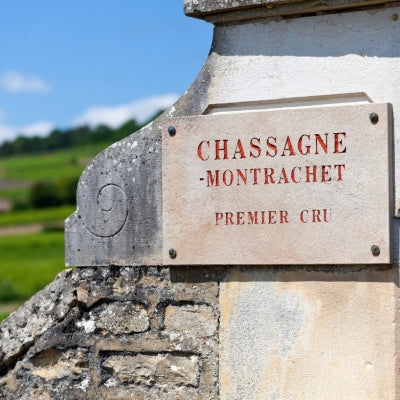
Discover Chassagne-Montrachet in six wines
Chassagne-Montrachet, located in the Burgundy sub-region of Côte de Beaune, is part of the "Golden Triangle" of villages, along with Puligny-Montrachet and Meursault, celebrated for producing some of the world’s finest white Burgundy. The commune boasts a trio of Grand Cru vineyards: Montrachet, Bâtard-Montrachet, and Criots-Bâtard-Montrachet, and around 55 Premier Cru vineyards. Its producers make Village-level Chassagne-Montrachet wines as well. Its opulent and finessed Chardonnay accounts for around two-thirds of production, and elegant, expressive Pinot Noir makes up the remainder. Wines are characterized as much by their pristine terroir storytelling and mineral depth as their fruit, with about 175,000 cases produced annually. Big winemaking names include Domaine de la Romanée-Conti, Maison Leroy, Domaine Ramonet, Bouchard Père et Fils, and Domaine Guy Amiot and Fils.
Fast facts
Name: Chassagne-Montrachet was an old Gallo-Roman commune, recorded in 886 as being under the Abbey of Saint-Seine with the Latin name Cassaneas or Cassania. This word is derived from “chestnut forest”, hinting at the local landscape at the time, with the name gradually evolving into Chassagne. The Montrachet part of the name means “bald” or “bare” mountain in old French, nodding to the slopes of today’s famed vineyards. It was added to become the village’s official name in 1879, replacing the former moniker Chassagne-le-Haut.
Location: Chassagne-Montrachet is located in the Côte de Beaune towards the southern limits of Burgundy. The appellation encompasses around 370 hectares of vines (11.42 Grand Cru, 158.79 Premier Cru, and 179.51 Villages). Altitudes range between 220 and 325 meters.
Climate and soil: The commune’s vineyards have east to southeast-facing orientations and are predominantly nourished by rich swathes of classic Burgundy limestone, as well as pebble, clay, and sand. Chardonnay vines cultivated closer to neighboring Puligny-Montrachet in the north of the commune grow on thinner soils, enhancing the mineral-rich character for which Chassagne-Montrachet is known.
Grapes: Chardonnay (around 65%) and Pinot Noir (around 35%).
Appellation: Chassagne-Montrachet acquired its AOC status in 1937.
Food pairing: The power and opulence of the appellation’s whites make them perfect for poultry or veal with light sauces or salmon dishes and seafood. Lightly-spicy Asian cuisine is also ideal as it contrasts with the rich, fruity core of the wines. The red wines are potent and tannic, complementing the texture, weight, and savoriness of roast lamb and grilled pork. Feathered game is also an excellent match, with the textured earthiness in the wine and the food complementing one another.
Fun fact: Until as recently as a generation ago, Chassagne-Montrachet was known for its red wines, rather than its whites. As the wider region’s white wines began to gain acclaim and more value, producers pivoted to Chardonnay.
Westgarth Wines has curated a diverse selection of white and red Chassagne-Montrachet from our portfolio for you to explore!
Indulge in the wines:
Let’s start with the village’s top vineyard: Montrachet, crafted by the iconic Domaine de la Romanée-Conti. The house cultivates around 0.68 hectares across three parcels on this revered site using biodynamic methods. Its 2015 garnered 95 points from Burghound for its opulent exotic fruit, like lychee, mango, and white peach, delicate hints of petrol, citrus tones, and muscular body. A firm backbone of acidity, long dry finish, and mineral depth speak of classic Montrachet.
Based in Puligny-Montrachet with holdings across Chassagne’s Grand Cru vineyards, Domaine Leflaive is renowned for its premium, biodynamically farmed Chardonnay. This Bâtard-Montrachet Grand Cru is crafted from fruit from three different parcels (two in Chassagne and one in Puligny close to the commune border). Powerful and fragrant with layers of citrus peel, pear, peach, petrol, woody hints, and delicate lavender, this vibrant, concentrated wine is built for cellaring – but will require patience!
Albert Bichot is a historic family producer established in 1831, famous for owning six estates across prime Burgundy regions and for making top-tier domaine and négociant wines. This White Burgundy from one of Chassagne-Montrachet’s Grand Crus is gently exotic with ripe yet finessed orchard fruit, woody hints, and spicy notes in a rich, layered mouth with firm, well-integrated acidity and a long finish. A brush of delicate sweetness adds to its appeal.
As the distinguished négociant branch of the highly-acclaimed domaine, Maison Leroy needs no introduction to wine connoisseurs. In line with its domaine philosophy, the merchant arm of the wine house is known for overseeing the biodynamic cultivation of the grower parcels from where it buys its fruit, ensuring select quality. A fine example of one of Chassagne-Montachet’s leading Premier Crus, Les Vergers, is located in limestone-clay soils just northeast of the village, close to the Saint-Aubin boundary. Layered tropical fruit, candied citrus, and hints of brioche are enhanced by an elegant, mineral-rich tension.
Les Caillerets Premier Cru site is found in the mid and upper Chassagne-Montrachet slopes northeast of the commune, close to the revered Montrachet. Boutique house, Caroline Morey (daughter of renowned winemaker Jean-Marc Morey) has crafted this 2018 from a 0.75-hectare parcel of 35 to 40-year-old vines, in a cuvée with a fresh palate, finessed texture, rich minerality, and a vibrant finish. It will unfurl beautifully over time.
While Chassagne-Montrachet is world famous for its exquisite White Burgundy, the reds from the Clos Saint Jean Rouge Premier Cru are admired for their elegance, ripe red fruit, feathery tannins, and earthy hints that belie their lighter hue. The eminent Domaine Paul Pillot, founded in 1900, is renowned for its organic viticulture, minimal intervention, and judicious use of oak to promote fruit purity and terroir expression. Its stylish 2020 from the Clos features kirsch, wild red fruit, and anise in a velvety body with subtle minerality and a long finish.
Want to read more? Take a look at some of our other blogs here:
Also in News

Collectors Corner: What will 2026 bring for fine wine?
Key themes likely to impact collecting decisions


